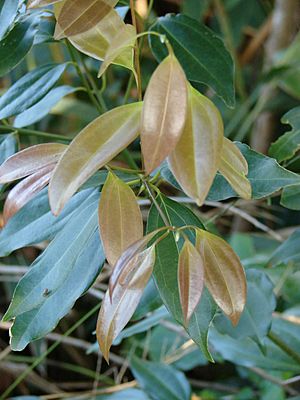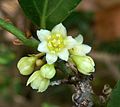Indonesian cinnamon facts for kids
Quick facts for kids Indonesian cinnamon |
|
|---|---|
 |
|
| Scientific classification | |
| Genus: |
Cinnamomum
|
| Species: |
burmannii
|
Cinnamomum burmannii is a plant often called Indonesian cinnamon. Its bark is used to make the spice cinnamon. This type of cinnamon is very common and often the most affordable, especially in the United States.
The oil from C. burmannii has a natural chemical called coumarin. It has more coumarin than some other types of cinnamon, like Chinese cinnamon or Ceylon cinnamon. You might also see Indonesian cinnamon sold as thin, rolled-up pieces called "quills."
Contents
What is Indonesian Cinnamon?
Cinnamomum burmannii is an evergreen tree. This means it stays green all year long. It can grow up to 7 meters (about 23 feet) tall. The tree has bark that smells nice. Its branches are smooth and have sharp angles.
Leaves and Flowers
The leaves of the Indonesian cinnamon tree are shiny green. They are oval-shaped. Each leaf is about 10 centimeters (4 inches) long and 3 to 4 centimeters (1 to 1.5 inches) wide. Small yellow flowers appear on the tree in early summer. These flowers later turn into dark, berry-like fruits.
Where Indonesian Cinnamon Grows
Cinnamomum burmannii comes from Southeast Asia and Indonesia. It is often found in places like West Sumatra and the western part of Jambi province. The Kerinci area is especially known for growing high-quality cinnamon.
Growing Conditions
This tree loves warm, wet, tropical weather. It has also been brought to other parts of the world with similar climates. For example, it was brought to Hawaiʻi from Asia in 1934 to be grown as a crop. In Hawaiʻi, it has spread widely and is now considered an invasive species. This means it grows so well there that it can sometimes take over areas where native plants used to grow.
How We Use Indonesian Cinnamon
We can get a fragrant oil from the bark, leaves, and roots of Cinnamomum burmannii. The bark is, of course, used as the spice cinnamon.
Other Uses
The leaves can be used as a spice too. They are sometimes used in preserved foods and canned meats. They can be a good substitute for laurel leaves. The center part of the tree contains fat. This fat can be pressed out and used in industries. The wood from the tree is also valuable. It is used to make nice furniture and other detailed wooden items. In some places, C. burmannii is also used in traditional Chinese herbal medicine.
Gallery












